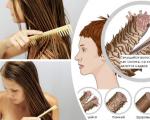How to choose the right shampoo for different hair types? How to choose the right shampoo for your hair depending on your hair type.
What should you pay attention to when buying this hygiene product? For a high price or a well-promoted brand? Or maybe a pleasant smell, beautiful packaging, interesting color and thick consistency? Or the amount of foam it produces. In fact, none of the listed indicators guarantees high consumer properties.
What does your hair like?
Many people choose shampoo experimentally - through trial and error. If the remedy is suitable, it means that it is the most suitable. True, everyone has their own ideas about what is good for and what is not so good. For example, many are sure that washed ones should squeak from cleanliness. And hearing this “creaking”, they rejoice at the right choice. But shampoo is more than just a means to wash away dirt and grease. After drying, the hair should be shiny, elastic, manageable and moisturized, combable well, and the scalp should be soft, moisturized, free of irritation and dryness. Among other things, a good shampoo smoothes the hair cuticle scales, makes them smooth and does not weigh them down.
Does your shampoo cope well with all this? Congratulations, keep using it.
Reading the label on the shampoo bottle
Some people prefer not to experiment on themselves, but to rely on the experience of others. The following information is especially for them...
So, the basis of any shampoo is surfactants, or detergents, which are responsible for the washing ability of the product. The quality of shampoo is influenced not so much by their quantity as by their quality. The softer these detergents, the better it is for the scalp and hair. The most common are:
Ammonium laureth sulfate;
- ammonium lauryl sulfate;
- sodium lauryl sulfate;
- sodium laureth sulfate;
- TEA laureth sulfate;
- TEA lauryl sulfate.
Many inexpensive shampoos use the first 2 detergents. They are inexpensive, wash away dirt and grease well, and are easily removed from the hair. But they can dry out your hair and scalp. The last three surfactants (surfactants) are usually added to high-quality shampoos, including those for dry and damaged hair.
Try to choose a shampoo with a higher quality detergent, especially if you wash your hair every day or have colored hair or sensitive skin
Now let's find out what additives in shampoos are needed for what?…
1. Proteins (vegetable protein). Helps restore damaged and permed hair.
2. Keratin is the protein that makes up hair. Provides protection to the hair surface.
3. Humectants (glycerin, plant extracts panthenol, propylene glycol, sorbitol).
4. Ultraviolet filters and fruit wax - protect hair from pollution and sun.
Myth four. Washing your hair every day is harmful.
In fact. You can wash your hair every day, especially for those who live in big cities, since a lot of pollution accumulates on the hair. Choose a shampoo labeled “for daily washing.” Hair is afraid not of frequent washing, but of drying it with a hot hairdryer.
Myth fifth. 2 in 1 products work no worse than conditioner and shampoo separately. At the same time, you save time and money.
In fact. We can agree with the savings, but contact between conditioning additives and detergents leads to a deterioration in the effect. So these tools must be used separately. Conditioners not only make combing easier, but also neutralize the alkaline effects of shampoo. These products restore damaged hair, provide protection from harmful environmental influences, chemicals, heat and make styling easier.
Myth six. A good shampoo contains 20-30 ingredients.
In fact. If there are problems with your hair, then it needs a product with a large amount of care substances. But people prone to allergic reactions, on the contrary, need a shampoo with a simple composition.
What should shampoo be like?
Good shampoo It is designed to perform the main function - to wash away dirt and grease from the hair, but this is far from the only necessary property.
Even if, through trial and error, you have finally found the ideal “candidate” for the role of your dream shampoo, test it for strength. Indeed, in addition to cleansing, it must also perform a number of other functions - depending on the properties stated on the packaging.
For example, giving hair shine, making strands silky, elastic and bouncy, nourishing the scalp, moisturizing and retaining moisture in the hair shaft, preventing it from drying out during the day.
Different hair types
Please note that universal shampoos “for all occasions” are ineffective. Hair wash should be selected depending on your hair type. After all, the composition of shampoo for oily hair differs from the component environment presented in products for normal and dry strands.
- So if your hair the roots quickly acquire a greasy coating, and the ends are dry, then you need a special shampoo containing microsponges and microspheres. The first removes oily shine from the head, the second nourishes dry ends.
- If your hair is dry, you need a nourishing, restorative shampoo containing proteins, collagen, oils, plant extracts and vitamins that would restore the structure of the strands, make them strong, and well moisturize the scalp and hair shaft.
- For those with normal hair favors a soft product that is not overloaded with nutritious, drying components. This should be a shampoo that maintains a normal water-oil balance in the scalp. Basically, such products contain herbal ingredients and vitamins.
Here's a surefire way to ruin it hairstyle – use shampoo designed for a different hair type. Let's say, if you naturally have coarse, unruly hair, then after using a shampoo marked “Super-Volume” you risk getting a “dandelion” hairstyle.
Reading the ingredients on the package
Any shampoo must contain detergents. They are responsible for the quality of the hair wash, but they are different in nature.
For scalp and hair mild detergents such as sodium laureth sulfate, TEA laureth sulfate, TEA lauryl sulfate are preferred. These substances provide the hair with proper care and, as a rule, are included in expensive professional shampoos.
And such common detergents as ammonium laureth sulfate and ammonium lauryl sulfate, despite their good cleaning ability, often lead to dry scalp.
Also keep in mind that some widely advertised ingredients in shampoos are not all that beneficial. A striking example is silicone, which, despite the visible smoothing effect, has one significant drawback: it forms a film on the scalp that impedes the flow of nutrients and disrupts the circulation of blood and oxygen. After using this product, hair hangs like tow by the end of the day, and after frequent use it becomes brittle and the strands become dull in color.
Healthy Supplements
If you have damaged hair , pay attention to the presence of useful additives in the shampoo, such as proteins, keratin, propylene glycol, lecithin, fruit wax and B vitamins, in particular D-panthenol (provitamin B5), as well as various vegetable oils, such as burdock, jojoba and etc. All these components improve the hair structure and moisturize it from the inside.
Keratin is especially useful because it is identical to natural keratin, which is part of the hair structure, which is the main building material for our strands. It helps to regenerate damage in the hair shaft and smoothes out scales.
Myths about shampoo
There is a myth that a high-quality shampoo should form a rich foam. In fact, this is far from the case. For example, many medicated shampoos, as a rule, do not foam well due to the specifics of their composition. But this, of course, does not mean that they are of low quality.
How much foam a hair wash produces depends on the amount of detergents it contains. According to GOST, they should be at least 20%. But the abundance of detergents, in turn, varies depending on the shampoo intended for a particular hair type: for example, there are less of them for dry strands than in a shampoo for oily hair.
By the way, just because your shampoo has a “delicious” fruity scent, this does not mean that it contains only natural fruit extracts. The pleasant flair is most often explained by the presence of artificial flavors.
Selecting an air conditioner
The second step in the hair washing ritual is using conditioner. The most popular is conditioner-rinse, which is used every time after washing your hair with shampoo.
How to choose the right shampoo and conditioner for your hair?
Rinse conditioner makes the process much easier hair styling , as it protects them from tangling, makes them softer and less fragile. Also, a product of this type blocks the accumulation of static electricity and makes the strands submissive to the styling process.
You can choose an air conditioner from three possible options: lightweight, regenerating or therapeutic.
- Lightweight used daily for preventive purposes: it does not weigh down the hair and moisturizes it.
- Revitalizing conditioner Designed for damaged hair and can be used as a mask.
- Medicinal contains a large amount of nutrients and vitamins. Typically, it is used several times a week.
Leave-in conditioners
Recently, many stylists recommend using leave-in conditioners. They are quite functional: they provide protection from sun rays, help maintain hair color after dyeing, and most importantly, they moisturize dry hair well.
Such conditioners contain approximately the same caring components as shampoos with a moisturizing effect: panthenol, natural extracts and oils. But this type of conditioner is not recommended for owners of oily hair, as it can create additional greasy shine and weigh down the strands.
If you have naturally dry hair, leave-in conditioner will give your hair a healthy look. Leave-in conditioners in spray form are very functional: you can take them with you on the road as a quick “revitalizing” hair product.
What hair products do you prefer?
Arevik CHAKHOYAN
Everyone has shampoo, but not everyone knows how to choose it. To ensure that the product brings only benefits, read the composition and avoid harmful components.
Many women and almost all men choose shampoo based on the principle “it smells good” and “is inexpensive.” Maximum - according to the recommendation indicated on the package. Dandruff? So, we take anti-dandruff shampoo. Does your hair get dirty quickly? So, for oily hair. Can you take a word for what the manufacturer writes? How to choose a shampoo so that it brings maximum benefits to your hair? Let's figure it out.
Why choosing shampoo is a responsible procedure
Gone are the days when the only purpose of shampoo was to cleanse. Now it is primarily a skin care product. Shampoo can moisturize and nourish hair, straighten and consolidate the effect after coloring, add volume and even prevent hair loss. The right shampoo can save you from many problems with your hair, but the wrong product, on the contrary, will aggravate the situation - dandruff will appear, hair type will change, or even hair loss will begin. Surely you have encountered the fact that the effect promised on the packaging never occurred: brittle hair did not become stronger, and unruly curls did not become more manageable. You should not go through bottle after bottle, trying to find “the one” product where the result will be similar to what is written on the label. Understand what types of shampoos there are, and in this case, soon you will definitely find a useful product on your shelf.
What is sold in the mass market
Most often we buy products from those companies whose names we know well. This is exactly what manufacturers are trying to achieve by investing a lot of money in advertising campaigns. The consumer is more likely to give preference to bright packaging from well-known brands rather than inconspicuous jars from unfamiliar companies. It turns out that products from famous brands are sold out in no time, while products from unpopular manufacturers remain on the shelf, often undeservedly. You shouldn’t attach much importance to the brand’s popularity, the design of the jar, or what the manufacturer promises. The most important thing in any cosmetic product is its composition, and in the case of shampoo, the components that have a cleansing effect (detergents) and substances designed to care for the hair.
Ingredients to Avoid
Ingredients in skin care cosmetics can be of synthetic and natural origin. Natural ingredients are more expensive, so they are generally not used in large industrial production. In order to save money, manufacturers of popular cosmetics use cheaper ingredients, which ensures the low cost of shampoos.
Basically, such products contain surfactants - surfactants - or sulfates, which provide good cleansing, but have a rather aggressive effect on the scalp and the hair itself. In the composition, these substances are listed as Sodium Lauryl Sulfate (SLS), Sodium Laureth Sulfate (SLES), Ammonium Lauryl Sulfate (ALS), Ammonium Laureth Sulfate (ALES), Cocamide DEA, Cocomidopropyl Betaine, TEA Layril Sulfate, TEA Laureth Sulfate. Other “bad” components in shampoos are Triethanolamine (TEA), Diethanolamine (DEA), Monoethanolamine (MEA) - foaming agents and emulsifiers. Shampoos also contain harmful preservatives: Methylchloroisothiazolinone, Methylisothiazolinone, Methylparaben, Propylparaben. All these ingredients are allergens and toxins, can cause irritation, and destroy the protective fatty film of our skin, leading to dysfunction of the epidermis. When choosing a shampoo, try to avoid the listed components so that washing your hair does not have any other effects other than cleanliness and improvement of the condition of your hair.

Ingredients that (do not) care for hair
Manufacturers of hair products promise soft and shiny hair immediately after the first use. This is actually possible, but an instant effect is achieved with the help of silicones (it seems that they are now on everyone’s lips). Most often this is a substance called Dimeticone. The harmfulness of silicones to humans has not been proven, but they also do not provide any real benefit. The fact is that silicones envelop the hair, creating a kind of shell around it. This is what explains the softness and smoothness that appears in our hair immediately after washing. The condition of the hair does not improve, but is only masked. In addition, components of other products - masks, sprays, oils and serums - do not penetrate through the formed “framework” to the hair, which makes any care procedures useless. Silicones tend to accumulate on the hair, which makes it heavier and can lead to hair loss. If you need an immediate effect, then silicones are an effective way to quickly transform your hair, but shampoos with silicones are definitely not suitable for deep hair improvement.
What to look for in the composition
Products that contain natural ingredients have a truly beneficial effect on hair. The cost of such shampoos will be slightly higher, but they will provide complete care for your hair and scalp. Be sure to read the composition and look for safe ingredients: detergent components - Coco Glucoside, Lauryl Glucoside, Glutamate, Sodium Coco Sulfate, Cocamidopropyl Betaine, silicone substitutes - Inulin, Sensolene, vegetable oils - Argania Spinosa Kernel Oil, Simmondsia Chinensis Seed Oil, Camellia Oleifera Seed Oi , natural emulsifiers - Cetearyl Alcohol, Glycerin Stearate SE, harmless preservatives - Potassium Sorbate, Sodium Benzoate, Benzyl Alcohol, Citric Acid.

Let's sum it up
Beautiful packaging, a well-known brand and a delicious smell are the manufacturer’s tricks designed to make you add this product to your cart in any way. The abundance of foam does not indicate the quality of the shampoo; on the contrary, it most often indicates the presence of synthetic emulsifiers. Natural shampoos, as a rule, do not foam much, but this does not make their cleansing properties worse. Carefully study the composition for the presence of harmful surfactants, sulfates, phosphates, PEGs and preservatives. If money allows, give preference to shampoos with natural ingredients. These are sold not only in specialized stores, but also in mass markets. Look for brands such as Planeta Organica, Natura Siberica, Organic Shop, Botavicos. The products of these manufacturers are found on the shelves of mass stores. Look for specialized natural cosmetics stores - there you will find a wide selection of products and, in particular, shampoos.
Problems arise with oily, combination and dry hair types, pay attention to the specifics of the skin, the body’s tolerance of certain substances, etc. For many reasons, correct hair is not so simple; you need certain knowledge of your body and similar hygiene products. Now we’ll look at skin types, talk about what substances to pay attention to in hair detergents, and touch on the topic of the best brands.
Consequences of choosing the wrong shampoo
Buying shampoo is not difficult, but how to choose the right option, where can you be sure that it will suit you? You can ask a sales consultant for help, describe the problem, talk about your hair type if you know it, but your own feelings are more important.
If you choose the wrong shampoo, the consequences can be severe. You may begin to have problems with your skin, acne will constantly appear, it will get to the point that even putting your head on a pillow or putting on a hat will be problematic due to painful sensations. In addition, pimples are visible to other people with the naked eye, some of them are not under the hairline, which leaves an imprint on the skin.
Such manifestations are called seborrhea or seborrheic dermatitis, depending on the specifics and symptoms. If such diseases occur, often even changing the shampoo does not help; you will have to contact a specialist in skin diseases and undergo a course of treatment.
Hair types and shampoo selection
In 90% of cases, you can choose the right shampoo for your hair only by knowing your hair type. The following three types are considered the most problematic:
- Oily hair - such hair quickly becomes greasy, acquires an oily sheen, and sometimes has a specific smell. In this case, the shampoo should cope strongly with the secretions of the sebaceous glands, but at the same time not irritate the scalp, but soothe and normalize the secretion of the glands.
- Dry - prone to split ends, unruly, hard to the touch, tangled. In this case, the best hair shampoo should saturate the scalp and each hair with vitamins, and provide gentle care and moderate moisturizing;
- Combination – dry ends and oily roots – are the main characteristics of this hair type. Choose a shampoo that has a double effect, simultaneously saturating the hair with vitamins and coping with the secretion of glands. This product often contains conditioner and cleansing agents in its formula.
Depending on what type of hair you have, the choice of shampoo will be radically different. Of course, on the tubes with these detergents they write what kind of hair it is created for, but you often have to try different options. The main thing is that it doesn’t fit, replace it immediately without reusing it.
It is important to rinse the shampoo thoroughly when washing your hair. Residues of even the mildest product on the hair cause a negative effect, irritate the skin and sometimes lead to serious consequences.
What to look for first: good composition, lack of sulfates, quality and other aspects
You need to choose a good shampoo wisely - this does not mean buying the most expensive one. Often, even expensive hygiene products add such a list of chemicals that they have a detrimental effect on the scalp.
At the same time, a cheap shampoo purchased at a pharmacy will be devoid of 80% of harmful expensive additives and will be based on herbs and plant extracts, which will provide healing and gentle effects.
- It is better if your choice contains the maximum amount of natural supplements, it will be based on natural ingredients, such as:
- Hop fruits;
- Natural oils;
- Barley;
- Green tea;
- Egg yolk;
- Chamomile;
- Series;
- Propolis;
- Nettle;
- Tar;
- Eucalyptus;
Henna, etc.
This list can be continued for a long time, however, you will not be satisfied with natural ingredients alone and substances such as salicylic and benzoic acids, sulfur, zinc, sulfur and other more complex and difficult to pronounce chemical elements must also be present.
But there are chemical additives that should be avoided at all costs. These include:
- Mineral oils, which are a product of refining petroleum products, ensure that their content is minimal or completely absent.
- Formaldehyde is a controversial component; it should also be no more than 1 percent.
- Parabens code E218, E214, E216. This is another substance whose harm has not been 100% proven, but it is better to protect yourself from using shampoo with this component.
Which brands should you prefer when choosing among tinted, natural shampoos, anti-dandruff, dry options, for oily, colored hair?
Of the shampoos that are on the shelves of pharmacies and supermarkets, the safest are three brands: “Green Mama”, “Fitoval” and “Natura Siberica”. It’s easy to choose a shampoo based on the composition of these three options; they contain a minimum of preservatives and other chemicals, are based on natural ingredients and are sold in several versions, for each hair type separately.
Natura Siberica is an excellent option for all hair typesIf you look at such popular brands as: “Clean Line”, “One Hundred Beauty Recipes”, “Fructis”, “Nivea” and others, they can also be used, however, 6 out of 10 bangs complain about their effect and related to them complications, or this cosmetic simply does not provide the desired result.
WATCH VIDEO INSTRUCTIONS
Choose if you can give preference to expensive brands, such as Bioderma or Cycle Vital. This branded cosmetics is popular all over the world and the manufacturer closely monitors the quality of the products. But remember, each bang is individual, the characteristics of our body are different and you cannot be 100% sure of one remedy, the choice is made by trial and error.
There is now a huge range of shampoos on store shelves. Before you make a purchase, consider whether you know everything about the rules for choosing the right product. After all, shampoo is not only the beauty of hair, but also its health. Beautiful, shiny, well-groomed hair attracts the attention of others. They are an important component of the entire image and style. Start choosing a shampoo by studying the label.
The most important thing when choosing a shampoo is to know your scalp type. The label will usually indicate what type of hair it is suitable for. Remember that the shampoo must match it. Otherwise, you will damage them, and it will take a long time to correct the mistake. Try not to buy “family”, “universal” products for all hair types. Don't make a choice based on the pleasant smell, color, or packaging. All these are not quality indicators, but advertising. High-quality shampoos have no odor, or it is completely different from others. Color – transparent or white.



Vitamins are useful for any hair. Vitamin B – normalizes the functioning of the sebaceous glands. The presence of vitamin C will make hair dense, strong, and elastic. Glucasil – nourishes and strengthens hair. Lipids - mineral and organic oils necessary to soften hair - make it silky.



